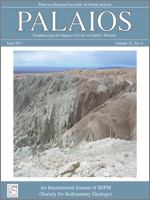Vertebrate paleontologists have proposed a model for the terrestrial end-Permian event in the Karoo Basin, South Africa. The scenario envisions vegetational collapse that resulted in a phased extinction of vertebrate taxa in the uppermost Daptocephalus Assemblage Zone and overlying Lystrosaurus Assemblage Zone. These biodiversity patterns are placed into composite stratigraphic sections at key localities, several of which are in close spatial proximity. We present a stratigraphic framework at two of these localities, Old Lootsberg Pass and Tweefontein, physically correlated over ∼ 2 km distance into which new and previously reported fossils are placed.
Glossopterid-dominated megafloras occur in both the Daptocephalus and Lystrosaurus biozones, along with palynological assemblages. Katbergia, a burrow used by others as an indicator of the transition and post-transition interval, occurs in paleosols much lower in the upper Daptocephalus Assemblage Zone, along with various subhorizontal cylindrical structures interpreted as vertebrate burrows. New vertebrate specimens include: (1) a large skull of either Daptocephalus leoniceps or Dicynodon sp.; (2) a partial skull with large canine assignable to either Dicynodon, Daptocephalus, or Lystrosaurus mccaigi; (3) a Lystrosaurus canine in grayish-red siltstone; (4) a skull of Lystrosaurus murrayi; and (5) a non-diagnostic post-cranial skeleton of lystrosaurid affinity.
These fossils are combined with the published Karoo-vertebrate dataset to test the stratigraphic position of the Daptocephalus and Lystrosaurus Assemblage Zone boundary. We conclude that: (1) glossopterids in the Lystrosaurus Assemblage Zone indicate persistence of the clade past what is considered to be an extinction event; (2) the presence of palynomorphs known from recovery clades above the proposed vertebrate-biozone boundary indicate that these groups were present in the basin, but outside of the megafloral taphonomic window; (3) the position of the proposed vertebrate assemblage-zone boundary is stratigraphically inconsistent and varies in its reported stratigraphic position at a minimum of 25 m, and up to 70 m, across a distance of only ∼ 2 km; and (4) terrestrial ecosystem dynamics only can be assessed when a high resolution stratigraphic framework is developed into which biostratigraphic data are placed and, thereafter, patterns can be evaluated.





